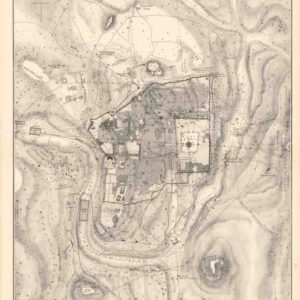A fantastic mid-19th-century panoramic view of Jerusalem.
Panorama of Jerusalem, seen from the Mount of Olives.
$575
In stock
Description
This plate consists of a lithographed panorama of the Old City, using the Mount of Olives as the perfect vantage point. In addition to converting the original photo to a more easily reproduced lithograph, the publisher has numbered all of the visible historical architecture, which then corresponds to an associated legend on an accompanying sheet. The view reveals how even in the mid-19th century, Jerusalem did not extend far beyond the scope of its ancient city walls. The surrounding countryside is characterized by cemeteries, hillocks, and green pastures.
The legend associated with this panorama:
- Hill of Evil Counsel.
- Aqueduct of Solomon.
- Mount of Rephaim.
- Cave of S. Peter’s Repentance.
- Mount Sion.
- Tomb of David.
- Scene of the Last Supper.
- Harem es Sherîf.
- Court of the Mosque Kubbet es-Sakharrah.
- Mosque el Aksa.
- Kubbet es-Sakharah.
- Jewish Hospital.
- Armenian Convent.
- Church of S. James.
- English Church.
- Castle of David.
- Greek Convent of S. John the Baptist.
- Minaret of Ibrahim’s Mosque.
- The Western Mountains.
- Tower of the Church of the Resurrection.
- Church of the Resurrection.
- Hospice of Saladin.
- Greek Convent of S. Basil.
- Latin Convent of S. Saviour.
- Minaret of the Serai.
- Tekhie el-Kasyeki Sultane.
- Residence of the Governor of Jerusalem.
- Barrack of the Haram es-Sherîf.
- A building belonging to the Daughters of Sion.
- Minaret. The ancient Palace of Herod.
- Church of S. Ann.
- Mount Gihon.
- Convent of the Dancing Dervishes.
- Herod’s Gate.
- Ancient Church of S. Mary Magdalene.
- Bastion of Godfrey of Bouillon.
- Kerm es Sheikh.
- S. Mary’s Gate.
- Saracenic Ruin.
- Golden Gate.
- Cemetery.
- Way of the Capture.
- Valley of the Kidron.
- Place where S. Stephen was stoned.
- Gethsemane.
- Arab Tower.
- Tomb of Absalom.
- Mount of Offence.
- Tomb of the Virgin Mary.
- Mount of Olives.
Publication information
In 1864, the same year that the first British Ordnance Survey of Jerusalem was commissioned, Italian engineer Ermete Pierotti published Jerusalem Explored, a seminal work on the history, archaeology, and architectural history of the ancient and holy city. This work included Pierotti’s notes and insights after years of surveying and mapping under Ottoman authority. The publication was divided into a text volume and a volume of plates. The latter included 63 lithographs showing everything from strategic views, across architectural plans and section profiles, to panoramic vistas of the Old City. Most of the lithographed plates were based either on photographs or drawings made by Pierotti and his team.
The plates were lithographed mainly by Thomas Picken of London and printed by the prominent British lithography firm William Day & Sons.
Cartographer(s):
Ermete Pierotti (1820-1880) was the oldest of nine siblings in a family from Pontardeto in Pieve Fosciana (the family built the Palazzo Pierotti, which has served as the town hall since 1877). Pierotti worked as a military engineer in Genoa and later served as a captain in the Engineering Corps of the Sardinian King. In 1849, he was accused of desertion and the theft of 3596 lire from the troop’s treasury, which resulted in a dishonorable discharge from the army. Pierotti then traveled to Jerusalem and Egypt, where he worked as an engineer. In Egypt, he discovered the foundations of the Alexandria Library while laying the foundations for a Greek church, but it was in Jerusalem that he would put his surveying and engineering skills to work.
Pierotti arrived in Jerusalem in 1854 as a consultant for the Franciscan Order, which had custody of many of the Christian holy sites in the city. During his time there, Pierotti was involved in the restoration of the Crusader Era Church of St. Anne, located in the Old City near the Pool of Bethesda. Working with Ottoman engineer Assad Effendi, he later contributed to the restoration of the Qanat as-Sabil, the main aqueduct that supplied Jerusalem with water, which involved repairing the aqueduct’s channels and cisterns. Other building projects included work on the Temple Mount itself and the construction of both the Austrian Hospice and the so-called Alexanderhof (HQ of the Kaiserlichen Orthodoxen Palästina-Gesellschaft) in the Christian Quarter of the Old City. And finally, he helped design the road from Jaffa to Jerusalem, a significant engineering feat at the time.
Pierotti became interested in the city’s history and archeology during his time in Jerusalem. He conducted several excavations in the Old City. He discovered several important artifacts, including an inscription in the Church of the Holy Sepulchre that proved the existence of a church on the site during the Byzantine period. Pierotti’s work in Jerusalem earned him a reputation as a skilled engineer and pioneering archeologist. He became known for his attention to detail and ability to work under challenging conditions. In addition to his many projects, Pierotti’s legacy consists of publishing his magnum opus: Jerusalem Explored. A Description of the Ancient and Modern City (1864), which included an entire volume of lithographed plates based on Pierotti’s plans and converted photographs.
Despite his many successes, Pierotti’s work and position annoyed the British, who increasingly sought to establish a scientific presence in the Holy City, if not a colonial one. When competition arose between Pierotti and Captain Charles Wilson’s team of English Royal Engineers conducting the first Ordnance Survey of Jerusalem and surroundings in 1864, Pierotti’s reputation was deliberately tarnished by the disclosure of his criminal past, and for the rest of his life, he struggled to regain recognition for his achievements.
Condition Description
Very good.
References
![[Jerusalem Drawing]](https://neatlinemaps.com/wp-content/uploads/2023/05/NL-01488_thumbnail-300x300.jpg)


